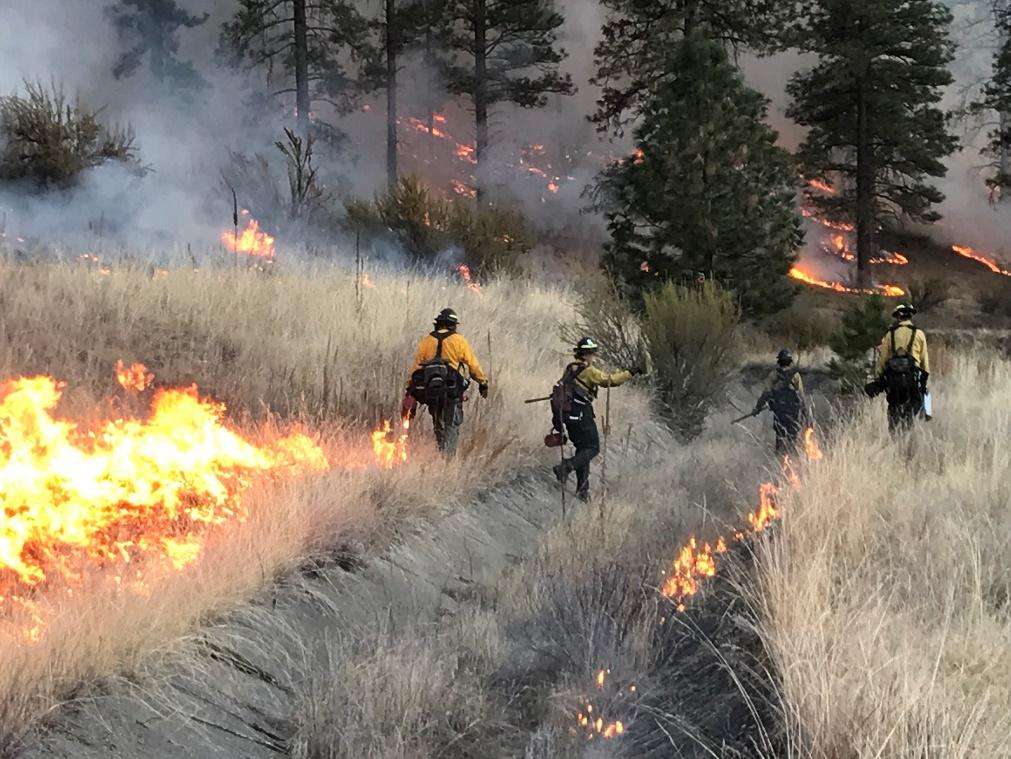ARCHIVED NEWS RELEASE
This document is provided for archival purposes only. Archived documents
do not reflect current WDFW regulations or policy and may contain factual
inaccuracies.
News release March 30, 2022
Matt Eberlein, 509-429-4236
Staci Lehman, Public Affairs, 509-710-4511
SPOKANE- Annual prescribed fires on Washington Department of Fish and Wildlife (WDFW) lands in Eastern Washington are scheduled to start in April, as conditions allow. Prescribed fires, a WDFW forest management practice, on WDFW wildlife areas reduce the risk of future wildfires, reduce the severity of wildfires when they do happen, and improve habitat for wildlife.
WDFW has two prescribed fire teams- including five full-time foresters and 18 burn team members- that conduct prescribed fires every spring and fall on public lands managed by WDFW statewide. With funding from the state’s 2021-2023 Capital Budget and grants, they will treat over a thousand acres of Eastern Washington wildlife areas with prescribed fire by the end of the 2022 spring season, including:
- Colockum Wildlife Area, 500 acres in Chelan County, 20 miles southeast of Wenatchee
- Rustlers Gulch Wildlife Area, Rustlers Gulch, 440 acres in Pend Oreille County, 20 miles west of Newport
- Oak Creek Wildlife Area, Cougar Canyon, 120 acres in Yakima County, 10 miles west of Naches
- Oak Creek Wildlife Area, Oak Creek drainage, 90 acres in Yakima County, 15 miles west of Naches
- LT Murray Wildlife Area, Hutchins Road, 320 acres in Kittitas County, 15 miles west of Ellensburg
Spring is the optimum time to both protect wildlife habitat and public safety through the use of prescribed fires, especially with WDFW lands often located in critical mid-elevation locations close to communities.
“Before the wildfire season starts is the best time to reduce hazardous fire conditions,” said WDFW prescribed fire manager Matt Eberlein. “Prescribed fires are monitored continuously until out, with public safety being a primary concern. We also work closely with our wildlife area managers on habitat concerns and the best times to burn each area to reduce wildlife impacts and stress.”
While the benefits of prescribed burning include increased public safety, improved wildlife habitat, a more fire resilient landscape, and a better experience for those who use public lands, we understand these fires can be an inconvenience while they are underway, particularly during hunting seasons. A small window of time when the weather is cool but not too wet to burn often makes it necessary to burn during hunting seasons.
“The areas slated for prescribed fire encompass portions of wildlife areas, leaving hundreds or thousands more acres available for public access,” said Eberlein. “In the long-term, the work will preserve ecosystems and enable people to continue using public lands.”
Signs are posted in advance of all prescribed fires to inform recreationists, but smoke and visibility can still be an issue. Please watch for fire personnel or equipment and slow down if you experience reduced visibility while driving.
Due to changing weather conditions, some of the burns may not occur. Additional burns on WDFW-managed eastern Washington lands could be announced if conditions allow.
WDFW stewards over a million acres of public land in Washington, which are managed to protect lands and water for wildlife and people. WDFW works to preserve, protect, and perpetuate fish, wildlife, and ecosystems providing sustainable fish and wildlife recreational and commercial opportunities.
